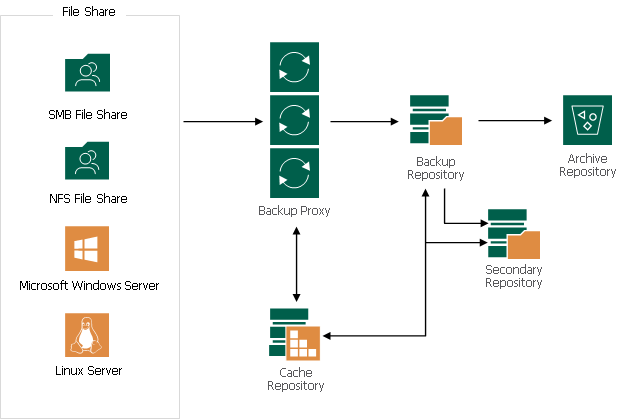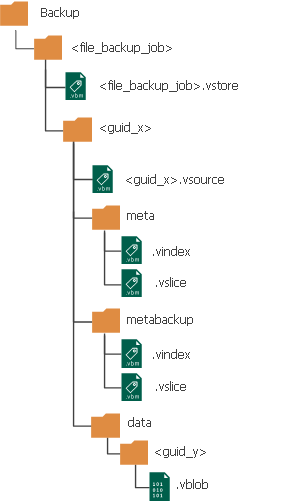NAS Backup Support
With Veeam Backup & Replication you can easily back up and restore content of various NAS file shares. The solution can be flexibly scaled to reliably protect massive amounts of data, even for the largest of enterprise organizations.
To protect your NAS file shares, you can use your existing Veeam Backup & Replication infrastructure. Just configure the following components:

For system requirements for NAS backup components, see System Requirements.
To learn how NAS backup components interact during file share backup, see How File Share Backup Works.
A file share is a storage device or data source available to multiple hosts through a computer network.
For supported file shares, see Platform Support.
File share backup jobs in Veeam Backup & Replication can read data from the following sources:
- SMB (CIFS) path
- NFS path
- Path to the storage snapshot folder
- VSS snapshot
Note |
Mind the following limitations:
|
To learn how to add NAS file shares to the backup infrastructure, see Adding File Share.
A backup proxy is an architecture component that sits between the file share and other components of the backup infrastructure. The backup proxy operates as a data mover that transfers data between the source file share and the backup repository. The backup proxy processes jobs and delivers backup and restore traffic.
You can assign the role of a backup proxy to any Windows-managed server added to your Veeam Backup & Replication infrastructure. By default, this role is assigned to the backup server. But this option is sufficient only for small installations where all components are located in the same network segment. For larger installations with larger workload, assign the role of a backup proxy to a dedicated server, as described in Adding Backup Proxy. After that, choose this backup proxy to process the backup traffic from file shares, as described in Adding NFS File Share and Adding SMB File Share.
To optimize performance of several concurrent tasks, you can use several backup proxies. In this case, Veeam Backup & Replication will distribute the backup or restore workload between available backup proxies on per-task basis, taking into account proxy connectivity and their current load. You can deploy backup proxies in the primary site or in remote sites. Mind that using a remote backup proxy may reduce backup performance and is not recommended. To minimize the network load during backup, locate the backup proxy closer to the source file share in the computer network: at the best they should be one hop away from each other.
A cache repository is a storage location where Veeam Backup & Replication keeps temporary metadata and uses it to reduce the load on the file share during the backup procedure. The cache repository keeps track of all objects that have changed between each backup session. This allows performing incremental backups from the file share super fast and very efficiently.
You can assign the role of a cache repository to a simple backup repository added to the Veeam Backup & Replication infrastructure. To assign this role, select the backup repository as a cache repository, as described in Specify File Share Processing Settings.
To minimize the network load during backup, locate the cache repository closer to the backup proxy in the computer network: at the best, they should be located on one machine.
A backup repository is a main storage location where Veeam Backup & Replication keeps all versions of backed up files for the configured period and metadata files. Backups stored in the backup repository can be used to quickly restore the entire file share to the state as of a specific restore point.
[Optional] If you want to retain specific files for a longer period of time, you can use cheaper devices for archive purposes. To enable file archiving, configure Veeam Backup & Replication to move backup files and metadata files from the backup repository to an archive repository. By default, usage of the archive repository is disabled and, after the retention period for the backup repository is over, backup files are deleted.
[Optional] If you want to store a copy of the file share backup in a different repository, you can configure a secondary repository where Veeam Backup & Replication will copy all backups created in the backup repository. The secondary repository can have its own retention policy and encryption settings. By default, no secondary repository is configured.
The table below describes which roles can be assigned to the different storage types.
Storage Type | Backup Repository | Archive Repository | Secondary Repository |
|---|---|---|---|
|
|
| |
|
|
| |
|
|
| |
|
|
| |
|
|
| |
|
|
| |
|
|
| |
|
|
| |
|
|
| |
|
|
| |
|
|
| |
|
|
|
1 You can store NAS backup files and backup copy files in a hardened repository with immutability, but these files will not be immutable.
2 If you use a Dell EMC Isilon/PowerScale storage system in the CIFS Share Access mode, make sure that you have assigned your service account to the built-in BackupAdmin role within Isilon. Otherwise, the access to the share will be denied.
3 If you plan to use HPE StoreOnce storage appliances, mind the following recommendations for optimal performance:
- A StoreOnce system can have multiple Catalyst stores, and large backup loads (exceeding 1PB) should be spread across more than one Catalyst store on the same StoreOnce system.
- Do not include Catalyst stores in a SOBR intended for NAS backups. This will reduce the global deduplication of the StoreOnce system.
4 An object storage repository added as a capacity tier in a scale-out backup repository can not be used for storing NAS backups. To archive NAS backup files to an object storage repository, assign the object storage repository as an archive repository when you create a file share backup job.
5 The following object storages are not supported for NAS backup: Amazon S3 Glacier, Amazon S3 Snowball Edge, Azure Blob storage Archive Tier, Azure Databox.
You can create two object storage repositories pointing to the same cloud folder/bucket and use these repositories for storing both NAS backups and Capacity Tier backups at the same time: one object storage repository will be used to store NAS backups, the other one – to store virtual and physical machine backups as a capacity tier in a single SOBR. However, these object storage repositories (mapped to the same cloud folder) must not be used across multiple Veeam Backup & Replication servers for the same purposes as it leads to unpredictable system behavior and inevitable data loss.
Deployment of Backup, Archive and Secondary Repositories
To use a storage, which is already added to the Veeam Backup & Replication Backup Infrastructure, to store file share backups, define it as a target storage when creating a file share backup job:
- Configure the backup repository and the archive repository as described in Define Target Backup Storage Settings.
- Configure the secondary repository as described in Specify Secondary Repository.
If the required storage is not added as a backup repository in your Veeam Backup & Replication Backup Infrastructure, add it as described in Adding Backup Repositories.
Data Structure in Backup, Archive and Secondary Repositories
Backup, archive and secondary repositories store file share backups as objects in VBLOB files (up to 64 MB each) of unstructured data. They also store metadata about the original files and folders on the file share and their structure.
When you run the file share backup job for the first time, Veeam Backup & Replication creates a full backup for all files and folders of the file share. During subsequent backup job sessions, Veeam Backup & Replication copies only files and folders that have changed since the last backup job session.
Although the file share backup job first creates a full backup and afterwards incremental backups, Veeam Backup & Replication does not create a separate file for each backup job run as it does during VM backup. Instead of this, it consistently creates multiple VBLOB files accompanied by metadata files that track all the changes on the file share.
Veeam Backup & Replication uses the following structure for storing the file share backup data in the backup repository:

Folder/File | Description | |||||
|---|---|---|---|---|---|---|
Backup |
|
|
|
|
| Folder in the repository that is dedicated to store backups. |
| <file_backup_job> |
|
|
|
| Folder that contains all data backed up by a specific file share backup job. Data for each job will be placed to its own directory. |
|
| <file_backup_job>.vstore |
|
|
| XML metadata file that describes the entire backup file for a specific file share backup job. |
|
| <guid_x> |
|
|
| Folder that contains all data for a single source. Data for each source will be placed to its own directory. |
|
|
| <guid_x>.vsource |
|
| XML metadata file that describes the single source object. |
|
|
| meta |
|
| Folder with binary metadata files that describe the content of the backup. If backup files are stored on a scale-out backup repository, this folder on each performance extent contains metadata for data stored on the same extent of the scale-out backup repository. For more information, see Scale-Out Repository as NAS Backup Repository. |
|
|
|
| .vindex |
| Binary metadata that describes backup files (names and versions). |
|
|
|
| .vslice |
| Binary metadata that describes allocation of data in VBLOB backup files. |
|
|
| metabackup |
|
| If backup files are stored on a scale-out backup repository, this folder on each performance extent contains replica of metadata stored on other extents of the scale-out backup repository. For more information, see Scale-Out Repository as NAS Backup Repository. |
|
|
| data |
|
| Folder with binary data. |
|
|
|
| <guid_y> |
| 1 Gb basket that stores VBLOB backup files. |
|
|
|
|
| .vblob | By default, a classic 64 Mb file that stores data from the file share backup. If necessary, you can convert NAS backup data files into the single file basket format recommended for storing data on HPE StoreOnce storage appliances. For more information, see description of the Convert-VBRNASBackupStorageFormat cmdlet in the Veeam PowerShell Reference. |
In This Section
- How File Share Backup Works
- Adding File Share
- Adding Backup Proxy
- Creating File Share Backup Jobs
- Starting New Backup Chain
- Performing Health Check and Repair for File Share Backup Files
- Viewing File Share Backup Properties
- Converting Backups from Non-Root to Root Shared Folders
- Converting Backups from SMB or NFS Shares to NAS Filer Shares
- File Share Data Recovery

